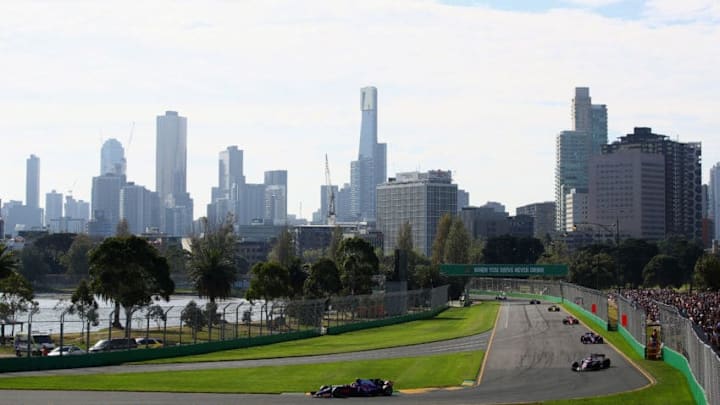Formula 1’s season opener in Melbourne is a special place for F1 fans with the pageantry surrounding the first race of the year. Look back its last five races.
It’s officially spring, testing is over, and 20 drivers are itching to start racing for keeps again. Being the Formula 1 season opener since 1996, the Albert Park Grand Prix Circuit has seen a lot of action since the Australian Grand Prix moved to Melbourne from Adelaide.
The 5.303-kilometer (3.29-mile) street circuit had a somewhat inauspicious start. Right from the first lights out, Jordan GP’s Martin Brundle was launched hard into the barriers but escaped unharmed, even running back to pits to get strapped into the spare car for a second restart.
Since that infamous beginning, Melbourne has gained a following as the opening race that crowns champions, with 13 Australian Grand Prix-winning drivers eventually crowned F1 champion. As we prepare for the 23rd edition of the Australian Grand Prix, look back at the last five contested at Albert Park.
2013
The 2013 race was the most action-packed, non-safety car race Melbourne has ever seen. With a total of 10 lead changes and a surprise winner in Kimi Raikkonen, who then drove for Lotus F1. Being the last year before the introduction of the current V6 Hybrid era, 2013 showed that Red Bull Racing were not completely invincible despite locking out the first row.
The drama started before lights out when Nico Hulkenberg’s Sauber encountered a problem and was classified as DNS. Three more retirements would follow the German: hometown favorite Daniel Ricciardo, Mercedes’ Nico Rosberg, and Williams’ Pastor Maldonado. Despite 10 lead changes up front, Raikkonen’s margin of victory was still of 12.451 seconds.
2014
The start of the V6 Hybrid era began well for Mercedes in qualifying. Lewis Hamilton and Nico Rosberg nearly locked out the front row for German works team, but Daniel Ricciardo spoiled that idea. The race, however, was not smooth sailing for Hamilton, who retired due to an engine issue at the start.
His teammate, who started in 3rd place, got a great jump at the start, leap-frogging both Hamilton and Ricciardo to lead into turn 1 and the rest of the race. In total, eight drivers would retire as Rosberg cruised to the first Mercedes victory since China in 2012 and their first of 16 total race wins that season. Ricciardo finished in 2nd place but was disqualified after a fuel flow violation per the technical regulations.
2015
More from Formula One
- Formula 1: Top Red Bull threat identified for 2024
- Formula 1: Why the Max Verstappen retirement obsession?
- Formula 1: Williams ‘mistake’ hints Logan Sargeant’s future
- Formula 1 awaiting key confirmation for 2024 season
- Formula 1: The ‘championship’ Max Verstappen only leads by 3 points
Mercedes were out to prove that 2014 wasn’t a fluke, locking out the front row and keeping the race between their two drivers. Lewis Hamilton started from pole and never lost control of the race. He was demoted to 2nd place briefly during his only pit stop on lap 25. He regained 1st for good two laps later. Despite this Mercedes-only battle up front, the margin of victory was relatively close in F1 terms at 1.360 seconds.
Most of the drama happened well behind and away from the Mercedes pair. There was a brief safety car period to clean debris and remove Pastor Maldonado’s Lotus from turn 2 after a single-car crash on the opening lap. Manor Marussia did not contest due to financial problems. Therefore, Will Stevens and Roberto Merhi withdrew. Williams’ Valtteri Bottas also withdrew due to injury. Daniil Kvyat’s Red Bull and Kevin Magnussen’s McLaren both encountered terminal issues prior to lights out and did not start.
2016
Nico Rosberg started in 2nd place behind teammate Lewis Hamilton for the 2016 race, but due to an impressive start by Ferrari’s Sebastian Vettel in 3rd and a poor start by Hamilton, the 2016 race became a strategy race quickly. With Vettel leading the first dozen laps, Ferrari defended the Mercedes undercut with Kimi Raikkonen.
However, an unplanned safety car after a turn 2 accident between Haas’ Esteban Gutierrez and McLaren’s Fernando Alonso put Mercedes back in contention. After the restart, the Mercedes pair worked together to get back out front. Rosberg eventually won while Hamilton salvaged a 2nd place finish. For the second consecutive year, Daniil Kvyat’s Red Bull lost drive on the way to the grid and did not start.
2017
For the fourth straight year, Lewis Hamilton started the Australian Grand Prix from pole, but like the 2016 race, it became a strategy race due to the improvement of Ferrari over the winter. The new Mercedes pair of Hamilton and Valtteri Bottas found themselves in a tough battle with Ferrari and could only salvage the podium positions as Sebastian Vettel took the win nearly 10 seconds ahead of Hamilton. Despite the fact that there were seven retirements in the race, no safety cars were issued.
Next: Top 10 Formula One drivers of all-time
How will this year’s season opener at Melbourne play out?
